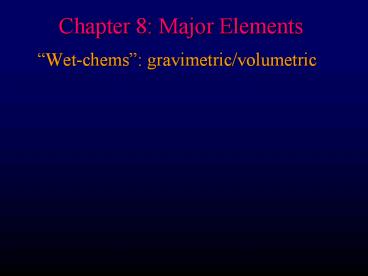Chapter%208:%20Major%20Elements - PowerPoint PPT Presentation
Title:
Chapter%208:%20Major%20Elements
Description:
Chapter 8: Major Elements Wet-chems : gravimetric/volumetric ... – PowerPoint PPT presentation
Number of Views:136
Avg rating:3.0/5.0
Title: Chapter%208:%20Major%20Elements
1
Chapter 8 Major Elements
- Wet-chems gravimetric/volumetric
2
Chapter 8 Major Elements
- Modern Spectroscopic Techniques
Figure 8-1. The geometry of typical spectroscopic
instruments. From Winter (2001) An Introduction
to Igneous and Metamorphic Petrology. Prentice
Hall.
3
Abundance of the elements in the Earths crust
- Major elements usually greater than 1
- SiO2 Al2O3 FeO MgO CaO Na2O K2O H2O
- Minor elements usually 0.1 - 1
- TiO2 MnO P2O5 CO2
- Trace elements usually lt 0.1
- everything else
4
A typical rock analysis
Must multiply by of cations in oxide ?
5
(No Transcript)
6
CIPW Norm
- Mode is the volume of minerals seen
- Norm is a calculated idealized mineralogy
7
Variation Diagrams
How do we display chemical data in a meaningful
way?
8
Bivariate (x-y) diagrams
Harker diagram for Crater Lake
Figure 8-2. Harker variation diagram for 310
analyzed volcanic rocks from Crater Lake (Mt.
Mazama), Oregon Cascades. Data compiled by Rick
Conrey (personal communication).
9
Bivariate (x-y) diagrams
Harker diagram for Crater Lake
Figure 8-2. Harker variation diagram for 310
analyzed volcanic rocks from Crater Lake (Mt.
Mazama), Oregon Cascades. Data compiled by Rick
Conrey (personal communication).
10
Ternary Variation Diagrams
- Example AFM diagram
- (alkalis-FeO-MgO)
Figure 8-2. AFM diagram for Crater Lake
volcanics, Oregon Cascades. Data compiled by Rick
Conrey (personal communication).
11
Models of Magmatic Evolution
12
- Harker diagram
- Smooth trends
- Model with 3 assumptions
- 1 Rocks are related by FX
- 2 Trends liquid line of descent
- 3 The basalt is the parent magma from which the
others are derived
Figure 8-6. Stacked variation diagrams of
hypothetical components X and Y (either weight or
mol ). P parent, D daughter, S solid
extract, A, B, C possible extracted solid
phases. For explanation, see text. From Ragland
(1989). Basic Analytical Petrology, Oxford Univ.
Press.
13
Figure 8-7. Stacked Harker diagrams for the
calc-alkaline volcanic series of Table 8-5 (dark
circles). From Ragland (1989). Basic Analytical
Petrology, Oxford Univ. Press.
14
- Extrapolate BA ? B and further to low SiO2
- K2O is first element to ? 0 (at SiO2 46.5 red
line)
Thus the blue line ? the concentration of all
other oxides
Figure 8-7. Stacked Harker diagrams for the
calc-alkaline volcanic series of Table 8-5 (dark
circles). From Ragland (1989). Basic Analytical
Petrology, Oxford Univ. Press.
15
Extrapolate the other curves back BA ? B ? blue
line and read off X of mineral extract
Results Remove plagioclase, olivine,
pyroxene and Fe-Ti oxide
Oxide Wt Cation Norm SiO2 46.5 ab 18.3 TiO2 1.
4 an 30.1 Al2O3 14.2 di 23.2 Fe2O3 11.5 hy 4.7
MgO 10.8 ol 19.3 CaO 11.5 mt 1.7 Na2O 2.1 il 2.
7 K2O 0 Total 98.1 100
Then repeat for each increment BA ? A etc.
16
Figure 8-8. Variation diagram on a cation basis
for the fractional crystallization of olivine,
augite, and plagioclase to form BA from B (Table
8-6). From Ragland (1989). Basic Analytical
Petrology, Oxford Univ. Press.
17
Figure 8-9. Equilateral triangle showing the
solution to the bulk mineral extract (shaded
area) best fitting the criteria for the variation
diagrams in Figure 8-8. From Ragland (1989).
Basic Analytical Petrology, Oxford Univ. Press.
18
Magma Series
- Can chemistry be used to distinguish families of
magma types?
19
- Early on it was recognized that some chemical
parameters were very useful in regard to
distinguishing magmatic groups - Total Alkalis (Na2O K2O)
- Silica (SiO2) and silica saturation
- Alumina (Al2O3)
20
Alkali vs. Silica diagram for Hawaiian
volcanics Seems to be two distinct groupings
alkaline and subalkaline
Figure 8-11. Total alkalis vs. silica diagram for
the alkaline and sub-alkaline rocks of Hawaii.
After MacDonald (1968). GSA Memoir 116
21
The Basalt Tetrahedron and the Ne-Ol-Q
base Alkaline and subalkaline fields are again
distinct
Figure 8-12. Left the basalt tetrahedron (after
Yoder and Tilley, 1962). J. Pet., 3, 342-532.
Right the base of the basalt tetrahedron using
cation normative minerals, with the compositions
of subalkaline rocks (black) and alkaline rocks
(gray) from Figure 8-11, projected from Cpx.
After Irvine and Baragar (1971). Can. J. Earth
Sci., 8, 523-548.
22
Thermal divide separates the silica-saturated
(subalkaline) from the silica-undersaturated
(alkaline) fields at low pressure Cannot cross
this divide by FX, so cant derive one series
from the other (at least via low-P FX)
23
AFM diagram can further subdivide the
subalkaline magma series into a tholeiitic and a
calc-alkaline series
Figure 8-14. AFM diagram showing the distinction
between selected tholeiitic rocks from Iceland,
the Mid-Atlantic Ridge, the Columbia River
Basalts, and Hawaii (solid circles) plus the
calc-alkaline rocks of the Cascade volcanics
(open circles). From Irving and Baragar (1971).
After Irvine and Baragar (1971). Can. J. Earth
Sci., 8, 523-548.
24
(No Transcript)
25
Figure 18-2. Alumina saturation classes based on
the molar proportions of Al2O3/(CaONa2OK2O)
(A/CNK) after Shand (1927). Common
non-quartzo-feldspathic minerals for each type
are included. After Clarke (1992). Granitoid
Rocks. Chapman Hall.
26
Figure 8-10a. Plot of CaO (green) and (Na2O
K2O) (red) vs. SiO2 for the Crater Lake data.
Peacock (1931) used the value of SiO2 at which
the two curves crossed as his alkali-lime index
(dashed line). b. Alumina saturation indices
(Shand, 1927) with analyses of the peraluminous
granitic rocks from the Achala Batholith,
Argentina (Lira and Kirschbaum, 1990). In S. M.
Kay and C. W. Rapela (eds.), Plutonism from
Antarctica to Alaska. Geol. Soc. Amer. Special
Paper, 241. pp. 67-76.
27
Fig. 8-17. After Le Maitre (1976) J. Petrol., 17,
589-637.
28
A world-wide survey suggests that there may be
some important differences between the three
series
After Wilson (1989). Igneous Petrogenesis. Unwin
Hyman - Kluwer































